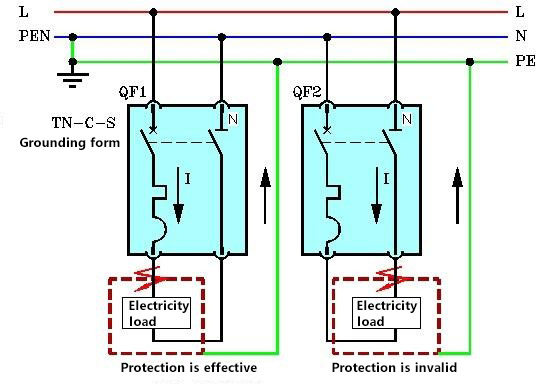How to install and wire 1P+N circuit breaker?
Many netizens proposed that after the L line is introduced from the N line of the circuit breaker, the current of the series circuit is equal everywhere, so the protection of the circuit breaker will not be affected. For this reason, I specifically add this part to illustrate.
Let's look at the picture below:

The circuit breakers in the figure are all 1P+N.
From the figure, we can see that the QF1 on the left is the normal port leading into the phase wire, while the QF2 on the right leads into the phase wire from the N-line port.
First notice a few points:
(1) The grounding system of the home assembly grid is TN-C-S. That is, the PEN wire drawn from the power supply is grounded before entering the home, and then separated into N wire and PE wire to enter the home.
(2) The exposed conductive part of the electrical load (ie, the metal shell) must be grounded, that is, connected to the PE wire.
(3) When a single-phase ground fault occurs, because TN-C-S belongs to a large current grounding system, the ground current is very close to the short-circuit current relative to N, so the single-phase ground fault protection device is a circuit breaker.
(4) A leakage protector can also be installed at the main entrance of the home assembly grid to improve personal safety protection.
Now start the analysis:
Look at the left picture first: the wiring direction in the picture is correct, so the trip unit of the circuit breaker phase line can play a role in line protection.
When a single-phase grounding fault occurs in the exposed conductive part of the electrical load, since its shell is connected to PE, the path of the fault current is: circuit breaker phase circuit → exposed conductive part of the electrical load → PE line, therefore, the circuit breaks The device must perform the protection operation.
Look at the picture on the right again: the wiring direction in the picture is reversed, that is, the phase wire is introduced from the N-line terminal of the circuit breaker.
First: We see that when the current leaves the electrical load, it enters the circuit breaker from the bottom pile head of the circuit breaker, that is, the direction of the incoming line is from bottom to top, which violates the rule that the incoming line must be from top to bottom. Therefore, the circuit breaker must be used with reduced capacity.
Second: When a single-phase ground fault occurs in the exposed conductive part of the electrical load, the direction of the fault current is: circuit breaker N-line circuit → exposed conductive part of the electrical load → PE line. We see that this path is completely absent Line protection capability.
If the leakage switch is not connected in the distribution network, the entire system will completely lose its protection, and serious electrical fire accidents will inevitably occur.
Third, if a short-circuit accident of relative N occurs on the outlet side of the circuit breaker, although it seems that the circuit breaker can perform normal protection operations, the circuit breaker needs to be derated for use (see the first description of the text), so the circuit breaker’s The protection may fail due to the reduced electrical life of the contacts.
The conclusion is: under any circumstances, never reverse the direction of the 1P+N circuit breaker! ! !




